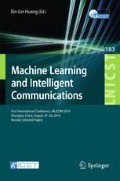Abstract
In this paper, an efficient unsupervised model is proposed to recognize simple actions and complex activities in traffic scenes which is named mixture LDA model. Under this framework, we use hierarchical Bayesian models are to describe three important components in traffic video: basic visual features, simple actions, and complex activities. This model adopts an unsupervised way to learn how to recognize traffic video. Moving pixels can be divided into different simple actions and short video clips can be divided into different complex activities in a long traffic video sequence, then we can achieve the purpose of recognizing different activities in the surveillance video.
Access this chapter
Tax calculation will be finalised at checkout
Purchases are for personal use only
References
Lu, H., Li, R., Zhu, Y.: Intelligent transportation system standard research. Highway Traffic Sci. Technol. 7(21), 91–94 (2004)
Saligrama, V., Konrad, J., Jodoin, P.M.: Video anomaly identification. IEEE Signal Process. Mag. 27(5), 18–33 (2010)
Snoek, J., Hoey, J., Stewart, L., et al.: Automated detection of unusual events on stairs. Image Vis. Comput. 27(1), 153–166 (2009)
Yin, Q., Zhang, R., Li, X.: Supervised clustering anomaly detection method research based on vector quantization analysis. Comput. Res. Dev. z2, 414–418 (2006)
Zhu, X., Liu, Z.: Human abnormal behavior recognition based on hidden markov models. Comput. Sci. 39(3), 251–255 (2012)
Wang, X., Ma, X., Grimson, W.E.L.: Unsupervised activity perception in crowded and complicated scenes using hierarchical bayesian models. IEEE Trans. Pattern Anal. Mach. Intell. 31(3), 539–555 (2009)
Hospedales, T., Gong, S., Xiang, T.: A markov clustering topic model for mining behaviour in video. In: IEEE 12th International Conference on Computer Vision, pp. 1165–1172 . IEEE (2009)
Kuettel, D., Breitenstein, M.D., Van Gool, L., Ferrari, V.: What’s going on? Discovering spatio-temporal dependencies in dynamic scenes. In: 2010 IEEE Conference on Computer Vision and Pattern Recognition (CVPR), pp. 1951–1958. IEEE (2010)
Author information
Authors and Affiliations
Corresponding author
Editor information
Editors and Affiliations
Rights and permissions
Copyright information
© 2017 ICST Institute for Computer Sciences, Social Informatics and Telecommunications Engineering
About this paper
Cite this paper
Tang, X. et al. (2017). Intelligent Recognition of Traffic Video Based on Mixture LDA Model. In: Xin-lin, H. (eds) Machine Learning and Intelligent Communications. MLICOM 2016. Lecture Notes of the Institute for Computer Sciences, Social Informatics and Telecommunications Engineering, vol 183. Springer, Cham. https://doi.org/10.1007/978-3-319-52730-7_36
Download citation
DOI: https://doi.org/10.1007/978-3-319-52730-7_36
Published:
Publisher Name: Springer, Cham
Print ISBN: 978-3-319-52729-1
Online ISBN: 978-3-319-52730-7
eBook Packages: Computer ScienceComputer Science (R0)

